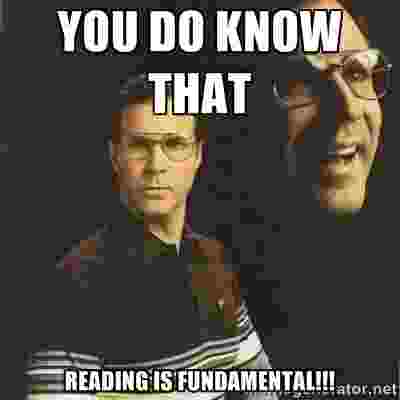
I do it for the fame and money…
Since the beginning of the semester I have been really working through making connections between the classes’ focus on elementary education and my personal focus on secondary education. There are many correlations and connections between the foci—several of which are obvious, and others which are difficult to fully synthesis and work with.
I have an obvious adoration of books and literature. And a genuine interest in literacy. And education as a whole. Clearing making this a joyous class for me.
I am in love with the fact I get to read books—all kinds of books! And am intrigued by the insights about the literacy of young students. And the clear support of reading and creativity in the education system.
But how can we truly connect all this? From my current standpoint and experiences, there is little to no interaction between Liberal Study students, SPED students, and students with a single subject focus. Elementary is separate from secondary. Special education is separate from both. But there has to be (and needs to be) a stronger connection and relationship between all the areas of study. There needs to be communication and collaboration between all educators in order to ensure the best possible education for all students.
This class has really given me a new found appreciation for elementary school teachers. First of all, they have to stay with the same set of students all day, every day—sometimes even for several years in placed in a loop system. If I did not have the opportunity to get a new set of faces every hour I probably could not fully function as a teacher. Secondly, they are responsible for covering a large array of content—they act as a sole source of information for all subjects. This would terrify me. Though I am completely captivated by all subject matters, I love having a solid foundation in a single content area. And lastly (for the time being), they prepare my students for me.
They teach them to read.
They teach them to write.
They set the foundation for my future students…they set the tone for my future classes.
No pressure!
It has been so insightful to delve into the ways in which elementary teachers can and should teach reading to students. And I think by the end of this class, I will be able to shift and alter my beliefs about teaching literature and reading to secondary students based on what I learn about teaching literature and reading to elementary students…
But not every student gets to opportunity to make these connections. To witness what is going on in other grade levels. And I believe this lack of collaboration and exploration between elementary and secondary education is creating a disparity in our education system…at least from my current standpoint.
There needs to be an understanding between how elementary teachers are teaching students and what secondary teachers are expecting of their students. A lack of understanding creates deep frustration for all, including the most important audience—students.
I love the ideas of wild reading, as presented by Miller, and I bow down to the elementary teachers who create wild readers out of my future students. It is important to create students who appreciate reading and literature (maybe I am biased by my own love for books?). But it is a great fear of mine that I will crush those wild reading habits when these readers reach my secondary classroom. Not that I intend to and not that I do not want to continue that habit of reading in the wild. But because reading for purpose is never as fun as reading for passion.
(Insert all my great ideas of maintaining an engaged and interested readership of my students—because they do exist.)
But how do I support the ideas presented by Miller in a secondary classroom. I love the idea of read-alouds, it is a great way to create a community and a sense of interest and wonder in students. But can the functions of a secondary classroom support that daily routine? I want my students to read for fun and maintain a log. But can that be supported with there will be many required readings (though some of those required readings will be innovative and fun AKA not Shakespeare or The Great Gatsby *mini gag reflex*). How will a support the great ideas presented by Miller?
(Answers to come by end of semester…maybe…hopefully…)
How do teachers from both elementary and secondary schools come together to create a plan of attack? A collaborative approach to maintain a continual and fluid approach to learning and reading? How do teachers bridge this gap?
I call for a joining of hands. A uniting of ideas. A collaboration of creativity. A combination of approaches. A strong sense of community among all educators—despite varying views, beliefs, philosophies, etc. I call for a respect and an understanding between all teachers for the sack of our students, our futures, and our world.
I hope to further explore these connections during my time in this class and I hope to develop a stronger sense of how to instill a collaboration between elementary and secondary teachers.


One Reply to “I do it for the fame and money…”
I’m really intrigued by the direction you took with this post. I don’t think many of us (myself included) think about how elementary educators ultimately do prepare at shape our future students for their secondary education so I found your observations and conclusions about the matter extremely insightful. I specifically liked how you focused on the importance and need for more cross-over and collaboration between the two levels of educations, and I appreciated your acknowledgement of the SPED students who are separate from both elementary and secondary students. Your solution to bridging the this gap is very much necessary if we want all students to have the opportunity to grow to their full academic potential, but I don’t think it can happen unless we start including more collaboration between the educational levels while our future educators are in college. As a liberal studies student who wants to teach special education at the secondary (and possibly collegiate) level, I feel like a bit of an outsider in my classes, including my SPED class. The main idea behind everything I’m learning is how I can apply it to elementary students. I understand the liberal studies program is designed to cater to my peers who do plan on teaching at that level; however, by excluding how the concepts I’m learning can be applied to the higher grade levels and the school not offering a program that truly fits my future career I feel as though I’m not able to reach my full potential as an educator-in-training, as well as my academic goals. If these connections and collaborative ideas were to be implemented through education reform within pre-credentialing programs and each school grade level we would not only have a stronger education system, but also more opportunities and exposures to benefit our future generations.